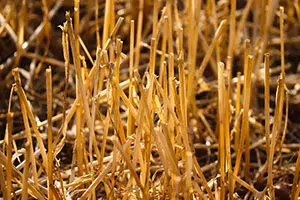 The residue and remains that remain on the ground after mowing are known as stubble . Stubble is formed by the parts of leaves and stems that fall to the surface after crops are cut.
The residue and remains that remain on the ground after mowing are known as stubble . Stubble is formed by the parts of leaves and stems that fall to the surface after crops are cut.
Stubble is important for soil protection. Although they are often thought of as nothing more than waste, they actually help combat erosion .
When managing land use, therefore, how to manage stubble must be analyzed. Stubble retention is key, but the quantities depend on the characteristics of the terrain and the region.
At a general level, it can be said that stubble contributes to water infiltration and minimizes the flow that is lost through evaporation. The stubble, thus, affects when defining irrigation.
Cereals produce a greater amount of stubble than that generated by oilseed plants . Barley and wheat are two of the species that promote the creation of an abundant level of stubble.
In order to eliminate weeds and fertilize the soil with ash, it is common for farmers to resort to stubble burning . However, this practice favors desertification and can lead to out-of-control fires . That's why many experts discourage burning stubble.
In the past, when general opinion favored stubble burning, the land was treated much less suited to the requirements of agriculture. One of the measures to prevent this practice from leading to a fire consists of generating a footprint around the area, that is, along its perimeter, where the fire cannot continue advancing; However, this step must also be done with certain technical knowledge to maximize field safety.
 Direct sowing is a proposal that allows eliminating both stubble burning and plowing, in a way that takes advantage of the soil conditions without altering it. To do this, it is necessary to use a special machine that, with the help of blades, allows you to plant the seeds without turning the soil over. Although this entails a monetary investment and the reorganization of planting, it guarantees the health of the soil and in the long term makes the field more profitable; The "old method" only wears it down until it is unusable.
Direct sowing is a proposal that allows eliminating both stubble burning and plowing, in a way that takes advantage of the soil conditions without altering it. To do this, it is necessary to use a special machine that, with the help of blades, allows you to plant the seeds without turning the soil over. Although this entails a monetary investment and the reorganization of planting, it guarantees the health of the soil and in the long term makes the field more profitable; The "old method" only wears it down until it is unusable.
Stubble can appear in different proportions. The better the corn yield, the greater the quantity. In numerical data, it is estimated that the residues released from sowing are around fifty percent of the dry weight of the production. This volume of organic matter is considerable and, given that it can be used to obtain different benefits, continuing to support its elimination does not currently make sense.
We must not ignore the degree of pollution generated by its burning: it not only directly affects the properties of the soil but also pollutes the air and contributes to the greenhouse effect through the release of gases. This is accentuated by the combination of rain (which usually appears at the time of year when the harvest is harvested) and human action. Systematically incorporating stubble into the soil gives it the minerals it needs for nutrition, enhancing its health and fertility, something that also has an impact on the flora and fauna of the place.
Los Rastrojos , finally, is the name by which a paramilitary group in Colombia is known. Also called Rondas Campesinas Populares ( RCP ), the Los Rastrojos group is dedicated to drug trafficking and seeks to control territorial strips.
